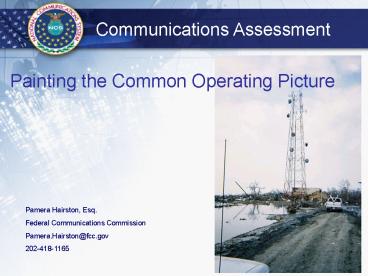Communications Assessment - PowerPoint PPT Presentation
1 / 24
Title:
Communications Assessment
Description:
Painting the Common Operating Picture ... Car. Boat. Air. Gathering Information: Local Site Visit. 8. JFO. State EOC. Gathering Information: ... – PowerPoint PPT presentation
Number of Views:25
Avg rating:3.0/5.0
Title: Communications Assessment
1
Communications Assessment
Painting the Common Operating Picture
Pamera Hairston, Esq. Federal Communications
Commission Pamera.Hairston_at_fcc.gov 202-418-1165
2
INCIDENT
ESF-2
FEMA advance team
FECC and ESF-2 team go to
RRCC
State EOC
JFO
3
Communications AssessmentPainting the Common
Operating Picture
- Provides situational awareness for operations
managers and policy makers at the highest levels
from those closest to the incident or event - Gives the background and context for decision
making
4
Communications AssessmentPainting the Common
Operating Picture
- Two Step Process
- Gathering Information or Assessing the
Incident - Reporting the Information or Completing the
Common Operating Picture
5
Communications AssessmentGathering Information
NCS/NCC
Fuel Security Access Public Safety Systems Power
Grid Broadcasters Satellite Others
Outages Priorities Offers
JFO
6
Gathering InformationConference Calls
- To and From NCS/NCC/JTRB
- Opportunity to learn priorities
- Opportunity to learn what issues need follow up
action (run to ground) - Opportunity to report status of follow up actions
on subsequent calls
7
Getting There From Here
Gathering InformationLocal Site Visit
- Visits to
- Local EOC
- Local Communications Officer
- Commercial Industry at Sites
- Visits via
- Car
- Boat
- Air
8
Gathering InformationOther ESFs
- JFO
- State EOC
9
Gathering InformationAssessing the Incident
- Initial AssessmentGenerally describes the
immediate state of communications following an
incident - Subsequent Assessments Reports that provide more
detailed information with specific needs and
recommendations based on interviews with state/
local officials, ESF counterparts at the state
EOC and JFO, and on-site industry representatives
10
Gathering InformationAssessing the Incident
- Whether as a part of the FEMA Advance Team or as
part of the team arriving at the JFO, the ESF-2
team should initiate contacts as soon as the
boots hit the ground - Face-to-Face is PREFERRED
11
Gathering InformationAssessing the Incident
- Information should be
- Timely
- Relevant
- Correctly Annotated
- Comprehensive
12
Gathering InformationAssessing the Incident
- Contact the following for initial assessment
- ESF-2 Counterpart at the state EOC
- ESF-3 (Public Works and Engineering) in the state
EOC and JFO - ESF-12 (Energy) in the state EOC and JFO
- ESF-13 (Public Safety and Security) in the state
EOC and JFO - Wireline Service Providers
- Wireless Service Providers
- State Broadcasters Association Representative
13
Gathering InformationAssessing the Incident
- With every POC you meet, always get
- Contact Information Name, Cell/Fax/Sat Phone and
E-mail - Issues Unique to POCs Systems/Services
- Status of Systems/Services
- Proposed Recovery Efforts and Time-Frame
- (if known)
- Immediate Needs
14
Gathering InformationAssessing the Incident
- Issues unique to system/services
- ESF-3 (Public Works and Engineering)
- ESF-12 ( Energy)
- ESF-13 (Public Safety and Security)
- Wireline Service Providers
- Wireless Service Providers
- Broadcasters
- PSAP/LMR Systems
15
Gathering InformationAssessing the Incident
The local Communications Officer is the keeper
of critical communications services information
- Title may be official or unofficial
- Knows about the public safety services in the
area of the incident, the maintenance of those
services and the people to contact
16
Gathering InformationAssessing the Incident
- Grueling grammar Batman, its interrogatives
- Who?
- What?
- When?
- Where?
- Why?
- How?
17
Gathering InformationAssessing the Incident
- For example
- Interview with ESF-2 Comms POC
- WHO the persons name, cell/fax/blackberry
number - WHAT services were provided to the area pre-
hurricane/event - WHAT state of services now in the disaster area
- Go through each system one at a time, letting
the EOC Comms person describe - WHAT systems are used
- WHERE each system is located
- HOW long the community has owned/used the system
- WHO services the system (Name/Number)
- WHO runs the system (state, local, co-shared)
- WHEN did the system go down
- HOW much of the system is down (neighborhoods,
parishes, city/county quadrants, percentage,
number of switches, etc.)
18
Reporting the InformationCompleting the Common
Operating Picture
Based on the information gathered, the Situation
Report (SitRep) paints the picture
- That policy makers and project managers use to
make informed decisions within the context of the
event (NCS/PFO/FCO) - That reflects what has been run to ground or
needs to be run to ground - That provides a consistent reporting format
19
Reporting the InformationSituation Report
(SitRep)
- Format
- Issues
- Solutions
- Success/Results
- Field Needs/ Follow up Action
20
Reporting the InformationSituation Report
(SitRep)
- All reports include
- Your name, location, contact information, date of
report - Names/contact information of persons who
contributed information - Locations visited
21
Reporting the InformationSituation Report
(SitRep)
- All reports
- Indicate whether the information is anecdotal
otherwise it is presumed factual - Avoid clichés and vague phrases
- Keep ESF-2 Mission foremost in your mind and your
report writing
22
Reporting the InformationSituation Report
(SitRep)
- Be Consistent in
- Spelling
- Abbreviations/Acronyms http//www.fema.gov/pd
f/plan/prepare/faatlist03_05.pdf - Writing style
- - sentences or bullets
- - dates
23
Reporting the InformationSituation Report
(SitRep)
- Those that fail to plan, plan to fail
- DEADLINES
- Check your time zone
- Check location when/where report is due
- Check time allotted for writing report
24
Classroom Role Plays































